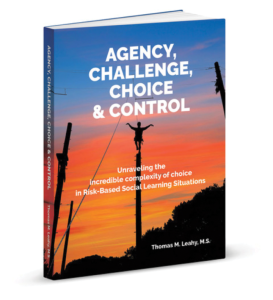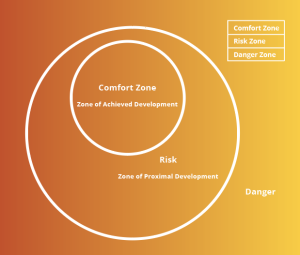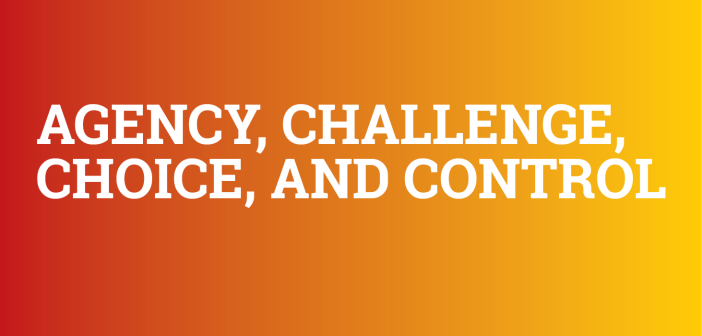Why do some aerial challenge participants struggle to a misadventure while others bask in the times of their lives? What can experiential programs, adventure parks, facilitators, guides, and monitors do to turn an emotional experience into a positive outcome? Those are the questions that inspired Tom Leahy to earn a master’s degree after more than 47 years of immersion in experiential education, and to publish his discoveries in “Agency, Challenge, Choice, & Control.”
What he learned can serve everyone from experiential program designers to first-time adventure park monitors, Leahy believes. API talked with him to find out how that might be so.
Control Is the Key
The end goal of experiential education, Leahy says, and often the by-product of an adventure in an aerial park, is to develop personal “agency”—”the ability to act with intention to achieve a desired outcome,” as he puts it.
How do we achieve this for those who struggle with the challenges we present? The solution, he believes, is to teach people how to be in control of their adventures (and their lives) by making good choices when they confront challenges. That is the foundational idea behind “challenge by choice,” which is a mantra for most experiential education. Whether on a zip tour or in an experiential program, challenge by choice allows participants to leave their comfort zone and choose their own level of adventure.
Sounds simple, yes? But challenge by choice, while widely preached, is far more difficult to achieve than most industry players understand, Leahy says.
“In all programs—facilitated, guided, even self-guided—we absolutely need to look a lot deeper into the experiences we offer, the stressors they create, and how we can help bring our guests and participants back into control,” he says.
And, we might add, help make their adventure a positive one.

Tom Leahy took what he learned from more than 47 years in experiential education and earning his master’s degree to publish his first book.
Challenge By Choice: It’s Complicated
Challenge by choice is a core concept of aerial adventures of all types, and it seems simple enough. But it is deceptively complex, Leahy says: “’Do what you want to do, have the fun you want to have, challenge yourself, and then just know when to stop.’ It’s a brilliant concept, but it’s deeply misunderstood and harder in a social setting than anyone would believe possible.”
For one thing, people often feel impelled to complete the entire course, and that negates any sense of choice. “Success,” says Leahy, “is seen as doing all seven or twelve zip lines and getting to the end of the game. On a challenge course, it’s catching the bar on the trapeze. In an adventure park, it’s wandering around and getting up to the black diamond or the green or blue, whatever route you choose, and completing it. People then judge themselves based upon how their performance compares with others they are closest to.”
On the opposite end of the scale, some may interpret challenge by choice to mean, “I don’t have to do anything, I can refuse to take on any challenge at all.” Not so, Leahy says. For one, participation on some level is expected when you are attending a program or outing with a social or professional group such as a school or business.
But participants can define success using their own parameters, with help from a guide or facilitator. “It can be defined by your goals, and participation can look like you choosing how much you want to do. For example, a person might say, ‘I want to do the green route, you get to do the black route.’ Or, ‘I want to stay on the ground and belay. You can jump off the Leap of Faith.’” This control over goal setting allows for growth, says Leahy.
As powerful as challenge by choice can be as a guiding principle, it’s not a panacea, he cautions. “It doesn’t solve the problem of people experiencing stress. The value that choice holds, I realize now, is that choice is a tool for us to learn how to be in control.
“Adventure is a place where we can learn how to be in control. Choosing when and where to stop is an important form of control in life.”
The Comfort Zone—and Beyond
Another key concept to understand is the “comfort zone,” the area of the ordinary, familiar, and ease. To learn and grow, or to experience an adventure, people must leave their comfort zone. But if you stray too far from your comfort zone, you may experience panic and terror. How can a guide or facilitator find that place where people are in a position where they can best learn or have fun?
“Lev Vygotsky, a Russian psychologist,” says Leahy, “was one of the first to recognize that for all of us, there’s things that we are comfortable with, things that we’re good at, things that we’ve learned to do, things where we feel in control, and that might be described as the ‘comfort zone,’ or ‘zone of achieved development (ZAD),’” as Vygotsky termed it.
Into the unknown. But growth does not lie in this zone. “Growth lies in what’s beyond, in what we’ve called the challenge zone, the stretch zone, the risk zone,” says Leahy. “We have lots of names for it. Vygotsky called it the ‘zone of proximal development,’ or the ZPD, that next area that encompasses the things that we want or need to learn and to expand into. We need to go there if we want to grow.”
This is where adventure gets tricky, though. Get too far from the ZAD and people enter what they perceive as the danger zone. Each individual’s comfort zone and ZPD is unique, so it’s not easy to know or predict when they will enter or exit them, or when they will feel stretched too far or stuck and unable to continue. Facilitators and guides need to be ready to assist at any moment.
“When people leave their comfort zone and move into the risk zone, they need more sensitive instruction, they need more support. They need to be helped with the choices and helped with the options. They also need to be protected from danger,” says Leahy.
Cascading Into Fear
Once people leave their “comfort zone” and explore new terrain (figuratively as well as literally), some quickly get so far outside their comfort zone they become paralyzed and incapable of motion, let alone learning.
Often, facilitators, guides, and other participants offer encouragement, which only makes matters worse. “They hear your encouraging words,” says Leahy, “but it shows up as pressure and expectation.” The cognitive dissonance between fear and expectation can overwhelm participants, leaving them stuck.
“What’s really at the core here is that in any other place in life, these people would have some level of control, they would simply stop,” he says. “But now they are caught in a social structure and on a course where the design leaves them feeling like they cannot turn back. They lose control, first over the sensations in their bodies, then over their emotions, and then over their own responses and what they’re going to do. And when we lose control, we get emotional. And that can be terrifying.”
Our brains at work. It’s important to recognize how the brain functions, he says. Our “strategic brain” allows us to think and make conscious decisions. Our “sensory brain” provides other information from our bodies—we feel tired, strong, shaky or stressed, for example. Our “affective brain” is the seat of our emotions. When we are under stress, the emotional part of our brains holds primacy and suppresses the strategic / cognitive functions. This can jolt us into a “fight or flight” response. In that state, we become incapable of strategic thinking, the use of our voice, the control of our body, or any sort of action.
“When I get emotional, I can no longer engage in the cognitive, strategic part of my brain,” says Leahy. “I start imagining all the terrible things that could happen.”

The “comfort zone,” which Russian psychologist Lev Vygotsky called the Zone of Achieved Development, is a surprisingly complex concept. It’s unique to each individual, and the dimensions of the adjacent “risk zone,” or Zone of Proximal Development—where learning and growth occur—are variable and often unpredictable. Guests may enter what they perceive as the “danger zone” at any moment, so facilitators and guides should be ready to offer help at all times.
Emotional Interventions and CAIR
The means to return such participants to a calmer state, where they can exercise some control over their adventure, Leahy says, is through an emotional intervention. “There’s basically four steps to that. My acronym for them is CAIR, pronounced ‘care,’” he says.
Connection. Before the adventure starts, says Leahy, it is important for guides and facilitators to connect with every single participant. “Greet everyone, share names,” he advises. And remember, as the guide, “You are in your comfort zone, but they are not. Be a gracious host and empathic support.”
Assurance. “When people are stuck and under a lot of stress, the first thing they need to hear is, ‘This isn’t going to be forever. There’s a way for us to resolve the problem that you’re feeling. And I assure you that I know what to do and I’m going to help you.’”
Leahy also uses slow, deep breathing to help a panicked participant relax and recenter—three full, deep breaths is usually sufficient, he notes. He asks the person to do the breathing with him, a process that furthers a sense of connection.
Inquiry. “Inquiry helps bring us back to the cognitive mind. Ask, ‘Does this feel like it’s too much? Would you like some help to regain control?’ These are all yes/no questions, which is where you start.”
As participants become less emotional (steadier breathing is a good sign), you want to prompt them with questions that require them to think and assess their choices. “This is all about re-engaging the strategic/cognitive brain,” says Leahy.
While you should provide options and assurance, it should be up to the participant to choose how to regain control of the situation. “We have them make choices, and then it’s important that they own that choice. And then they have to act on it.”
Reflection, the final step. “There needs to be just a little time for the person who had a tough time, who had to be evacuated from the course, perhaps, to reflect,” says Leahy. You want to avoid a situation where the participant simply walks away feeling like a failure, he says.
Through questions and conversation, he says, “You want them to arrive at something like, ‘I made a good decision. I have learned that I can be in control of my life. … I might even come back here.’”
The goal of reflection is to help the participant remember this as a “crazy, amazing growth experience” where they were supported by their guide or facilitator.
Four Key Statements
Facilitators, and guides for that matter, can easily get a sense of participants’ frame of mind and who may need some special attention, Leahy says, even before the action starts. Four statements from participants can help identify what their goals are, and what support they may need. They are:
What’s easy? “One, ‘What about this challenge feels easy for you?’ People might say, ‘putting on the harness is easy. And climbing up the stairs, that was easy.’”
What’s hard? “The second question is, ‘What is the challenge for you?’ That’s a combination of ‘what do you want to do?’ and ‘where do you see the stressors, the risks that challenge you?’ People might say, ‘I’m not sure I can balance on that. And it’s going to be above the ground. Is this lanyard going to hold me?’” Here, says Leahy, guides can offer reassurance and choices: “OK, great. It’s OK to test each step and then decide.”
What seems impossible? “Third question is, ‘What can’t you imagine about this?’ People might reply, ‘I don’t want to fall.’” This is another opportunity for reassurance, he says. For example, a guide might remind a participant of their experience at the training station: “You have already seen these belay systems work.”
What do you need? “The fourth question is, ‘What do you need for support?’” Participants may outline things they want help with, or things they’d prefer you not to do. These are boundaries like: “I’d like to choose where I am in the line on the zip line.” Or, “Just give me a little space. Give me a little quiet. Let me make this decision.”
The Bottom Line: Control
“These four statements, whether in a facilitated program or on a zip tour, put the person in control of their choices. And they allow them to set boundaries for the unhelpful but well intended interference from other people. They take a bit of practice, but for 40-plus years, I have seen them work,” says Leahy.
“That’s essentially how we put people in control of their adventure,” he continues. “For everyone from a challenge course facilitator to a zip tour guide, it takes only a minute or two to get this person aware and making good choices. Two minutes of prevention will eliminate tens of minutes of struggle and indecision.
“We need to anticipate the stressors and the small number of people who will not have a good experience. We, as guides and facilitators, need to prepare them with the warning of the challenge to come and the promise of choice, and when the time comes, we must help them take control of their adventure. We need to teach people how to develop control, how to maintain control, and how to regain control.”
And that applies whether you run an experiential program or an adventure park, Leahy adds.
“We need to remember, when we take human beings into a challenging, stressful experience, that we have an obligation, more than just simply getting them physically safe to the goalposts; we have a duty of care to help this be a positive, emotionally safe, physically safe, and growth-filled experience.
“I want to say to all my recreational peers, there is an incredible opportunity to provide our participants with more than just a physical thrill. A two-hour experience can be life changing with very small adjustments in how we interact with people” and help them experience their own level of control, he says. “They will then associate this amazing feeling with the experience you provided.
“But it is not easy to get our staff to that point. The mind shift isn’t that difficult, but people are so fixed on how they do things now, they can’t see the path forward.” Just like the person struggling at height, Leahy says, businesses and their employees, their facilitators or guides, have to shift their thinking to delivering 100 percent of their participants to a powerful, successful experience.
About “Agency, Challenge, Choice, and Control”
Tom Leahy’s “Agency, Challenge, Choice, & Control” describes his 47-year journey to understanding how and why adventure experiences—so powerful and positive for many—can also be terrifying misadventures for some. He also explains how aerial adventure operators and experiential programs can turn potentially negative experiences into personal triumphs. It is not a quick or easy read, as it reviews a lot of psychological and experiential literature and discoveries by a range of social scientists and educators. But it’s worth the effort to explore the factors that make adventure and experiential education so rewarding and beneficial.
To obtain a copy, head to: leahy-inc.com/tom-leahys-book/






